
If you ever met me, there are probably several adjectives I can guess you might use to describe me:
- Outgoing
- Talkative
- Cheerful
- Polite
- Drop dead sexy
Hey – a girl can dream, right?
I’m sure there is one other adjective people probably think but are usually too polite to say.
Quirky.
I’m totally cool with being called quirky. I like things most people don’t. I’m not afraid to take the unbeaten path.
As a result, I love quirky things. Which is what probably explains why I love Saipan as much as I do. Because as beautiful as her beaches are and as nice as her locals are, Saipan has a whole other personality.
She is quite a quirky island.
It’s these oddities that very often get left out of the “Required Places Visitors Must See” lists. And what shame that is. In my humble opinion, these little quirks are some of the best parts of this island.
Saipan Series: Saipan Oddities
Island Oddity #1 – Submerged Sherman Tanks
As you drive south down Beach Road, you will see some of the most beautiful shorelines in the entire world.
Facing the Philippine Sea, this stretch of the island is protected from large waves thanks to a coral reef. The waters are so clear, you can see fish and sea turtles from your car.
As you come into the Village of Susupe, you will find Kilili Beach. This beach was the primary invasion point for the Americans during the Battle of Saipan. It was here that over 8,000 Americans came ashore in less than thirty minutes total in June 1944.
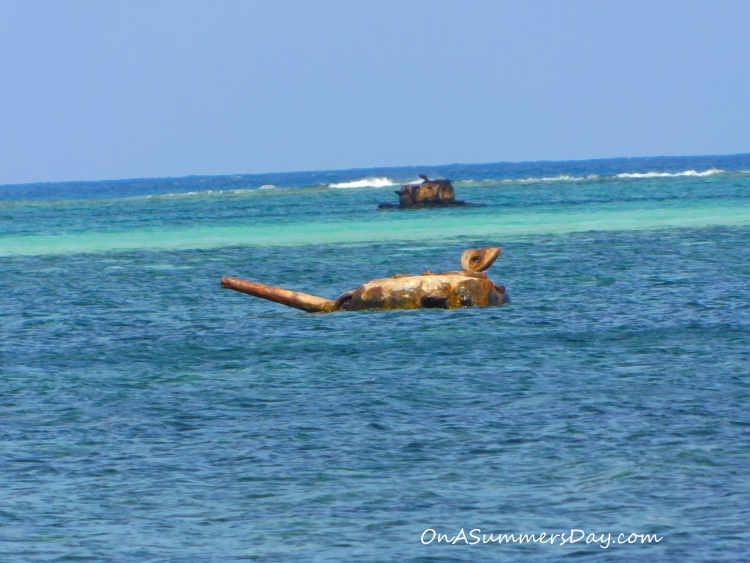
Kilili Beach | Saipan
Pull over and park near the Veteran’s Memorial. Head down to the beach behind it, and it is there you will find our first Island Oddity.
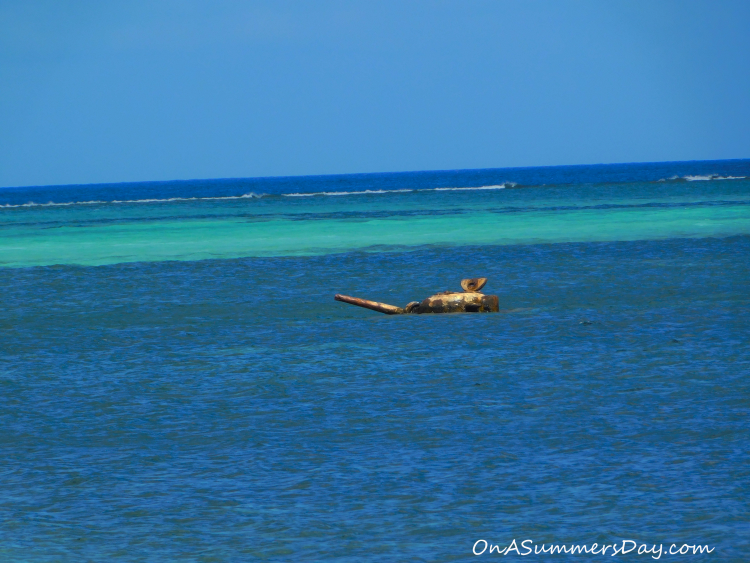
Kilili Beach | Saipan
Leftover from the Battle of Saipan, you will find two submerged Sherman tanks.
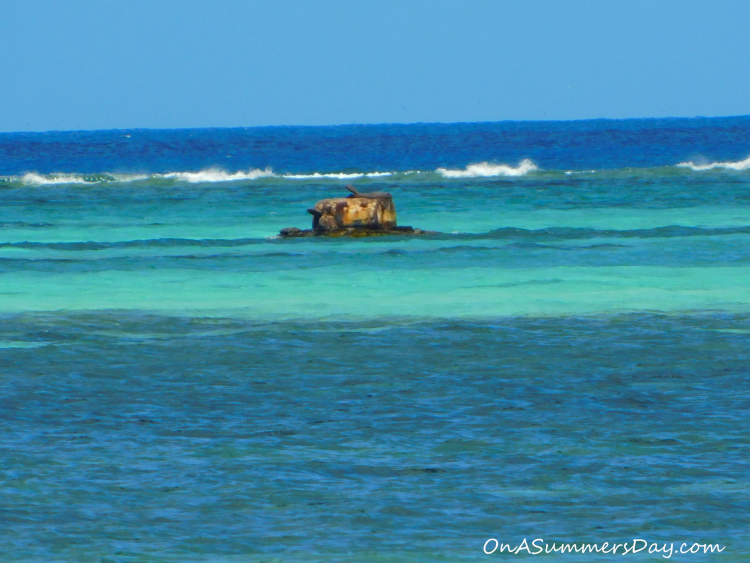
Kilili Beach | Saipan
No one is sure of the exact story of how they got there, but the best (and most likely) guess is the tide got misjudged, and they got stuck there. They have set there since 1944, and make for beautiful sunset pictures.
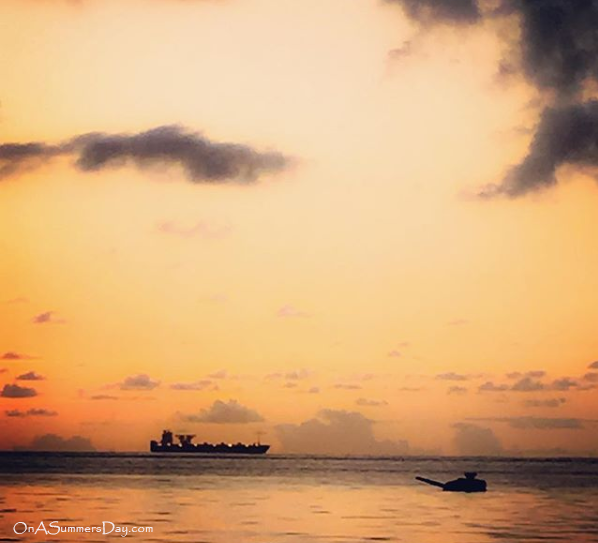
Kilili Beach | Saipan
You are allowed to swim out and snorkel around them. I’ve seen many swimmers jump off the top of the tanks as well. Just be sure to wear swim shoes. Tetanus really puts a damper on a good time.
Island Oddity #2 – Chamorro Canoe House
One of my favorite things to do when we move to a new city is to learn as much of its history as I can. I was tickled pink when I found out I was moving to Saipan because I knew the culture here was unlike any other place I’ve ever lived.
What I found out about Saipan’s culture and traditions did not disappoint.
The indigenous people are known as the Chamorro. They are a proud, sea-faring people. Thanks to the hard work of the Department of Community and Cultural Affairs, many of their cultural traditions are being revived for a new generation of Chamorros.
The first of many planned projects is located just a few yards from the submerged Sherman tanks.
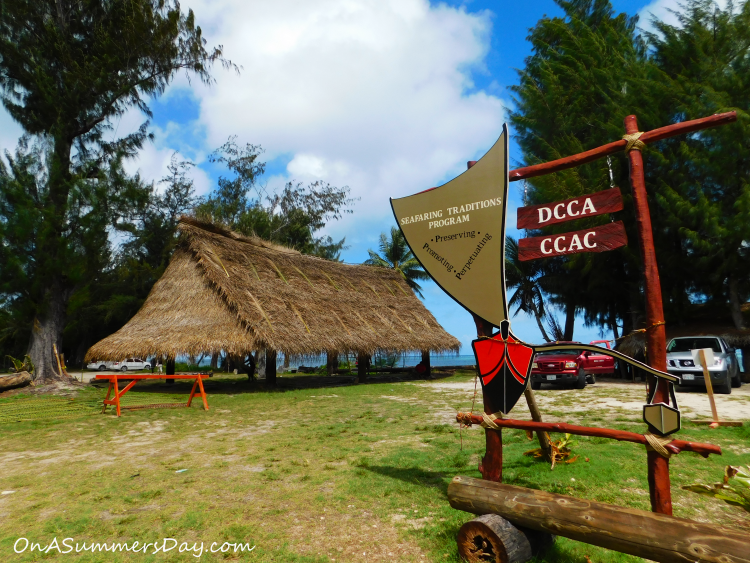
Chamorro / Caroline Canoe House | Saipan
Built using traditional methods and materials, this canoe house will be used as a classroom to help teach local traditions. It is hoped to also be used for community events and ceremonies.
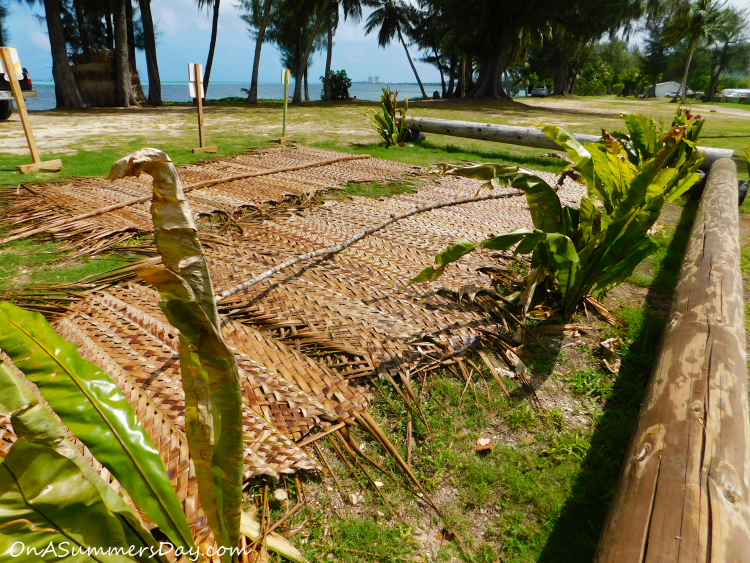
Canoe House | Saipan
It has been absolutely fascinating to watch the artisans hard at work. The process of building the canoe house has really taught me so much about traditional Chamorro building techniques. What a beautiful gift knowledge is to give!
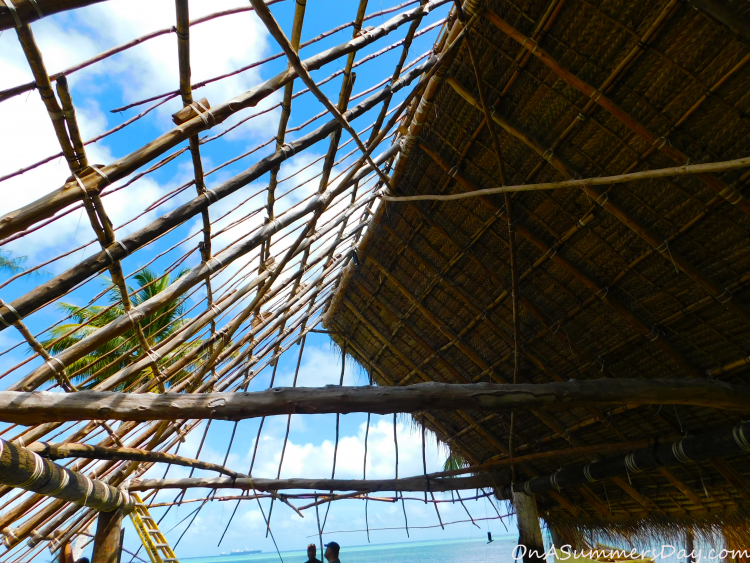
Chamorro Canoe House | Saipan
Island Oddity #3 – Kristo Rai Parish Bell Tower
Now we head north on Beach Road until we arrive in Garapan Town. Just before you hit the downtown district, you will find Kristo Rai Parish. The church is impressive to see and hard to miss with steel beams that run across it that are 120 feet long and 96 feet wide.
Though this church is beautiful, it is not the original building. Thanks to the Battle of Saipan, the original building was destroyed.
All, except for the bell tower.

Kristo Rai | Saipan
Built in 1876 by Spanish missionaries, the bell tower has survived German occupation, Japanese occupation, the Battle of Saipan, and three large typhoons – including Category 5 Typhoon Soudelor in 2015.
(For my North American readers: Typhoon = Pacific hurricane)
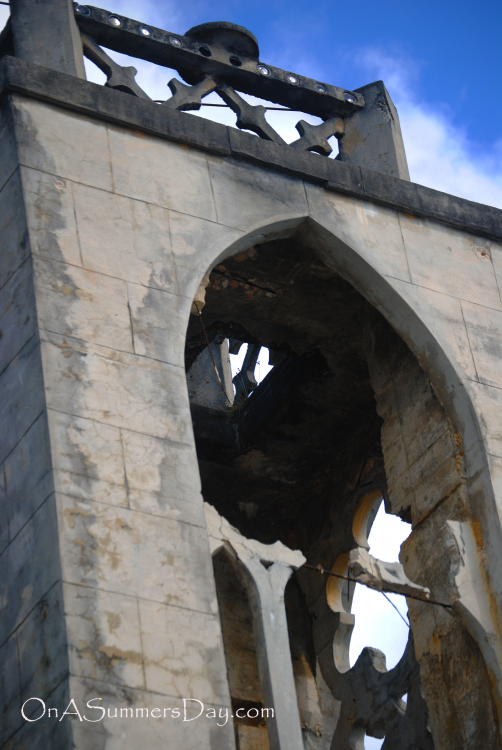
Kristo Rai Bell Tower | Saipan
Thanks to age and natural/man-made disasters, the bell tower is in disrepair. Please be careful when you’re taking pictures near it. This is one time a good zoom lens is your best friend.
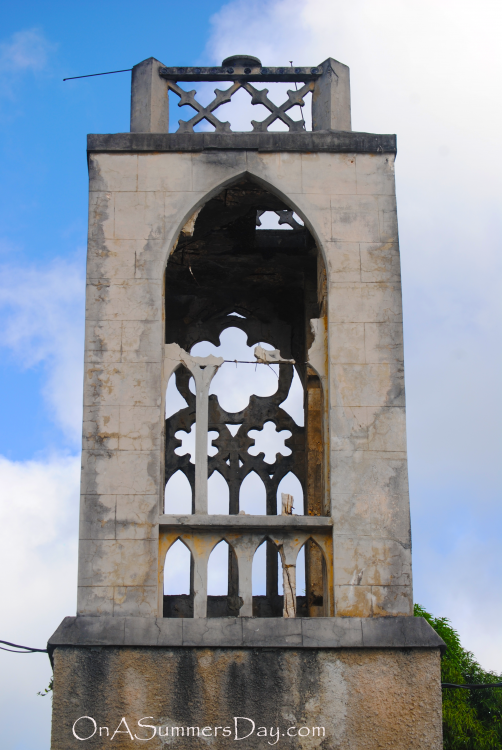
Kristo Rai Bell Tower | Saipan
Saipan Island Oddity #4 – PEACE sign
Now we turn off Beach Road onto Garapan Road (Route 308/ Hard Rock Cafe). Come to the end of the street and park in one of the parking lots on the corner of Garapan Road (it becomes Sugar Mill Road after the intersection) and Middle Road. Look towards the mountains, and there you will see one of my personal favorite things about Saipan.
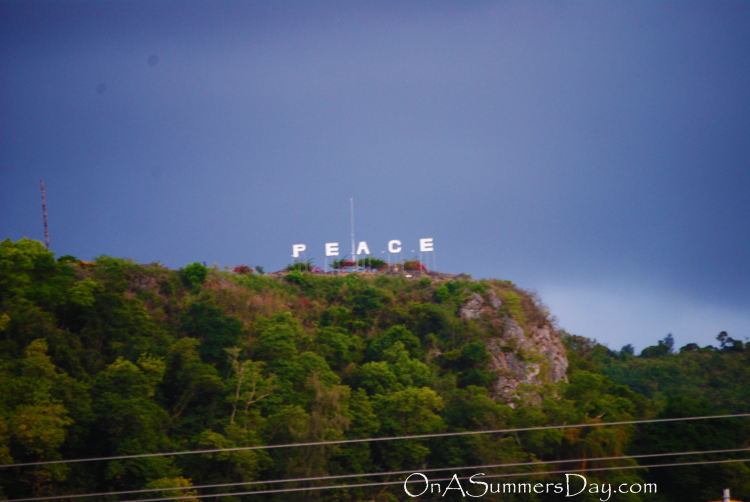
Peace, man. | Saipan
Because Saipan has known war first hand, it is hoped that the island never will again. And as such, you will see Peace signs all over the island. This one is the largest, looking down over Garapan, and out towards the port.
I’ve been told there is a park near the sign, but I have yet to figure out how to access it. The typhoon did a lot of destruction, and even almost three years later reconstruction continues. If anyone knows how to get to the sign, let me know in the comments, please and thank you!
Saipan Island Oddity #5 – Old Japanese Jail
Turning right (south) onto Middle Road, this next oddity is located about two miles down the road from the PEACE sign.

Bad boys, bad boys… | Saipan
The Old Japanese Jail was built in 1929 as first an island jail. Later, the jail was used to house American POWs during WW2.

Old Japanese Jail | Saipan
Three buildings remain. The larger one is said to have housed men, the smaller housed women, and the other building was administration. The lodging building no longer remains.
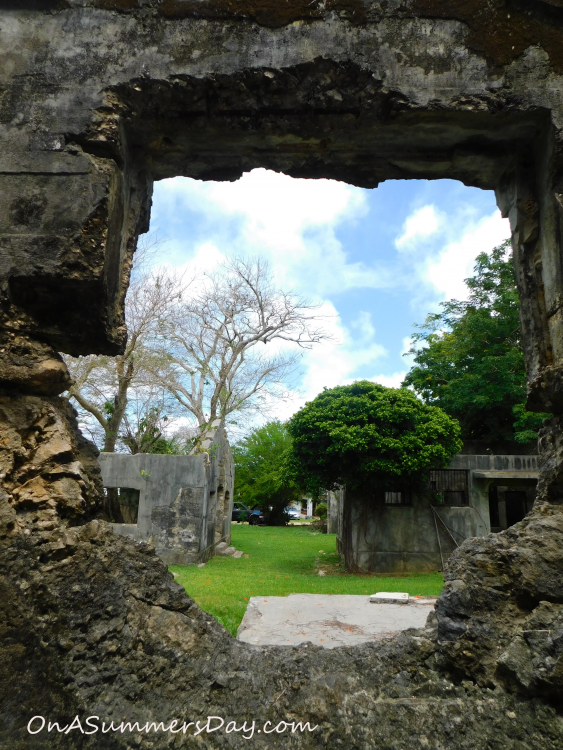
Old Japanese Jail | Saipan
There are bullet and blast holes littered all over the walls. There is also Japanese and English carved into the walls of the cells. A Marine unit took refuge in the jail during the Battle of Saipan, and evidence of their visit is on one of the inside walls in the men’s building.
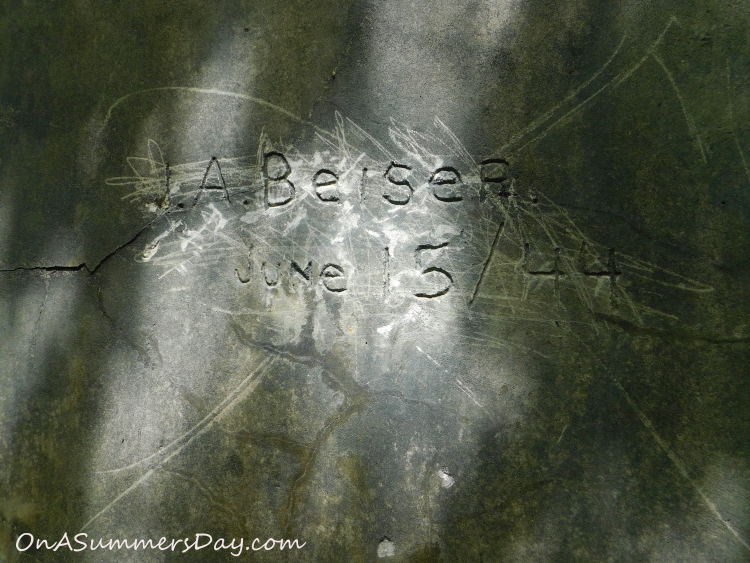
Old Japanese Jail | Saipan
The cells are tiny and inhumane. You can easily imagine that the prisoners suffered while being kept there. There is a persistent rumor that Amelia Earhart died in this jail. Walking through you can’t help but feel a bit creeped out. The ghosts of the past remain, even if you never see them, you feel them.
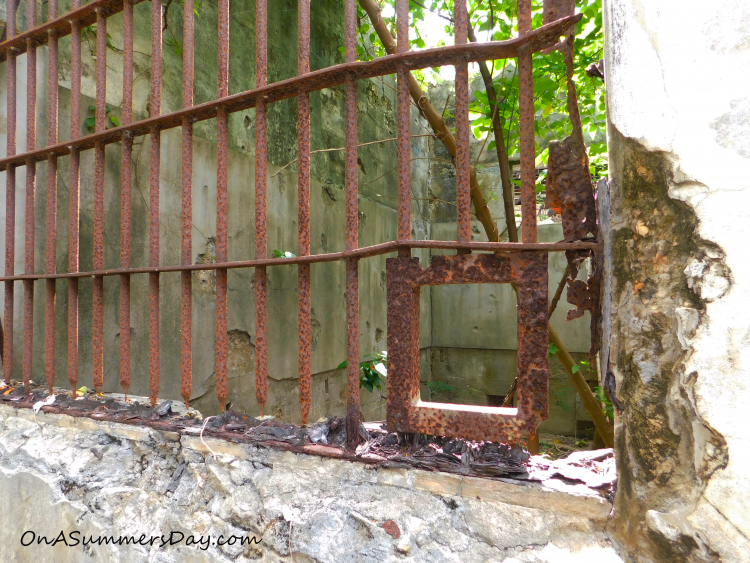
Old Japanese Jail | Saipan
Saipan Island Oddity # 6 – Sugar King Park
During WWI, Saipan was captured by Japan, who later occupied the island. The island was turned into sugar cane plantations and refineries were built all over the island.
The man who introduced sugar cane farming to the island was Haruji Matsue, aka the “Sugar King“. The park named in his honor is located just north of the Japanese Jail on Middle Road.
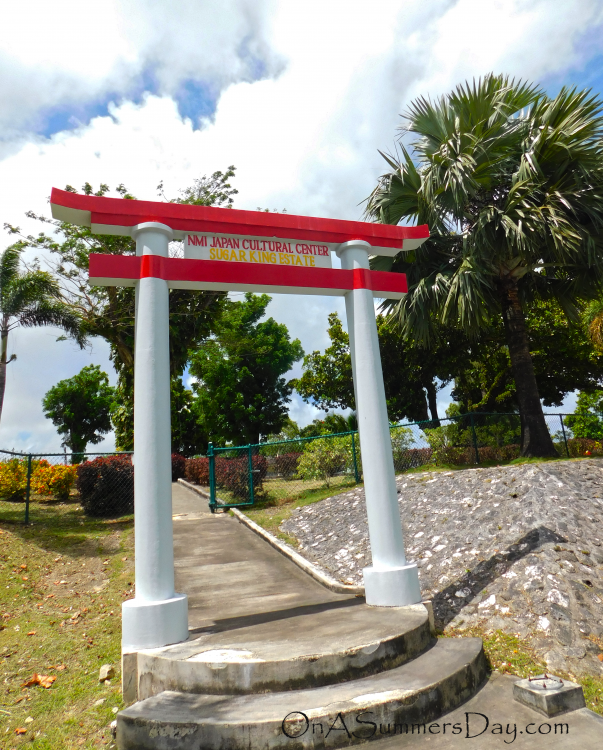
Sugar King Park | Saipan
This park is very little but packed full of enduring surprises. For instance, there is a steam engine that is leftover from the days when Saipan had a small train track. The tracks ran from the sugar cane fields to the processing plants. All that remains of the tracks today are now walking paths at Kalabera Caves (more on that below).
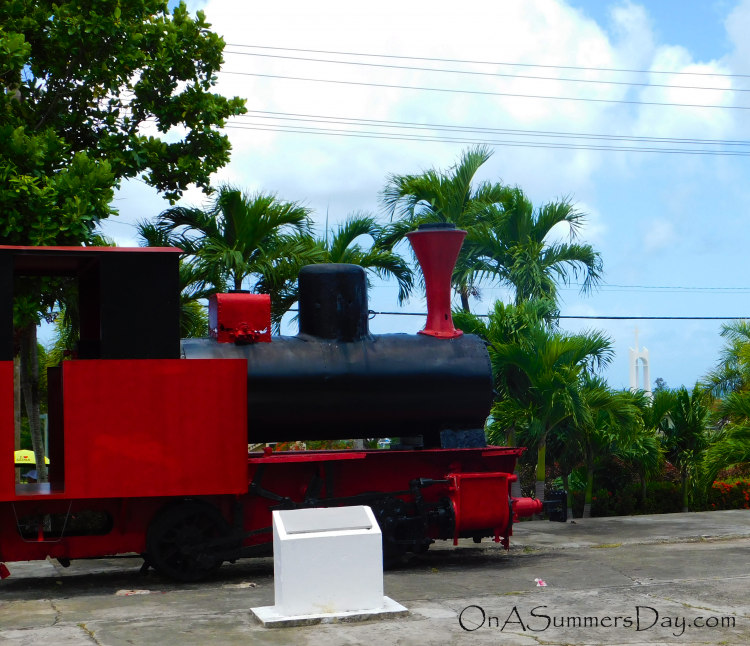
Besides the steam engine, the Kristo Rai steeple can be seen in the lower right side of the photo. | Saipan
In the back of the park is a Shinto shrine called the Katori Jinja. The original shrine was built in 1911 but destroyed during the Battle of Saipan. It was reconstructed in 1985 but did suffer some damage after Typhoon Soudelor.
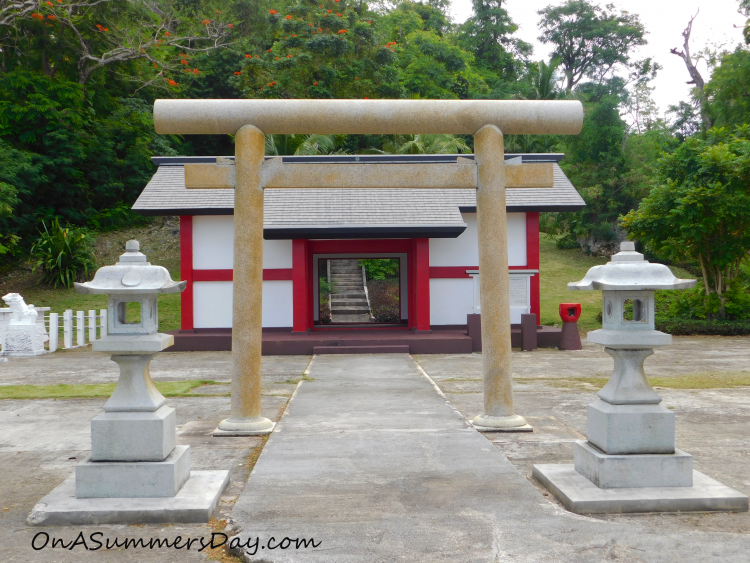
Katori Jinja | Saipan
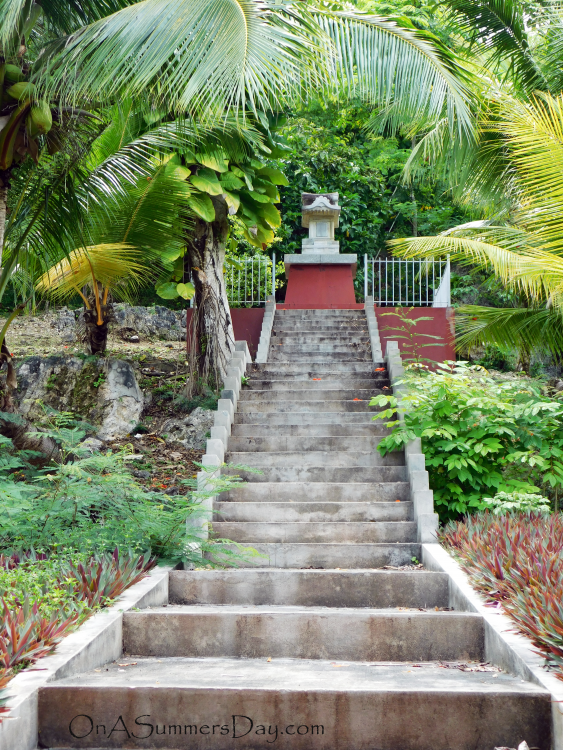
Katori Jinja | Saipan
Behind the shrine is Katori mountain, where there is an enjoyable hiking trail. The trail itself is not very long, but some of the stairs can be a bit tricky to maneuver.
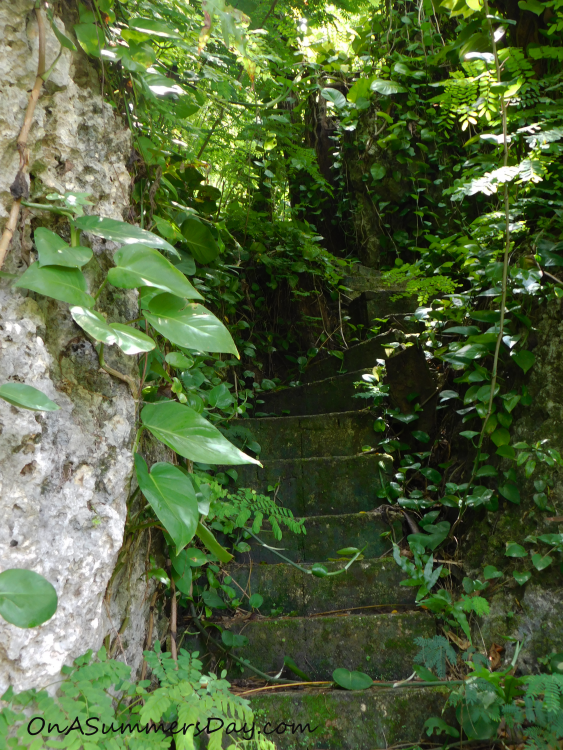
Watch that first step! It’s a doozy! | Saipan
The mid-point on the trail leads to you to the most beautiful, hexagonal building.
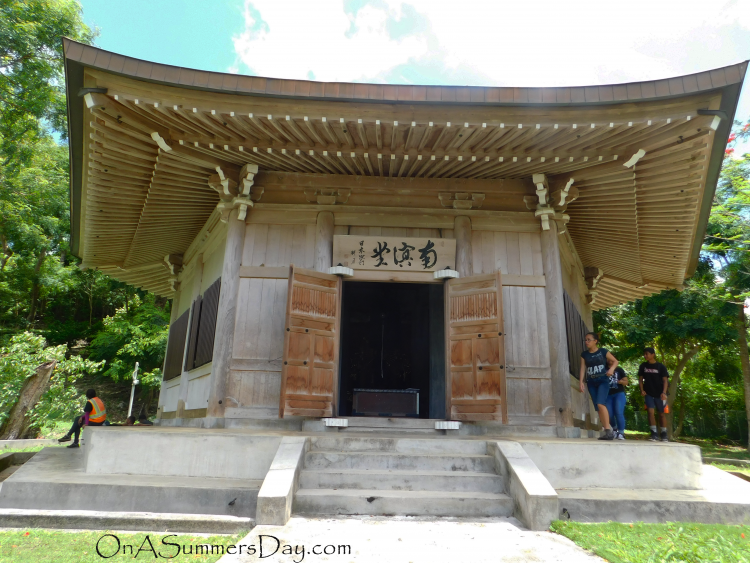
Saipan International House of Prayer
The Saipan International House of Prayer was built in 1990, by the relatives of the deceased Japanese who lost their lives during the Battle of Saipan. It is the most lovely place to sit and enjoy a cool breeze while collecting your thoughts. The building is dedicated to Jibo Kannon, the Buddhist Goddess of Mercy.
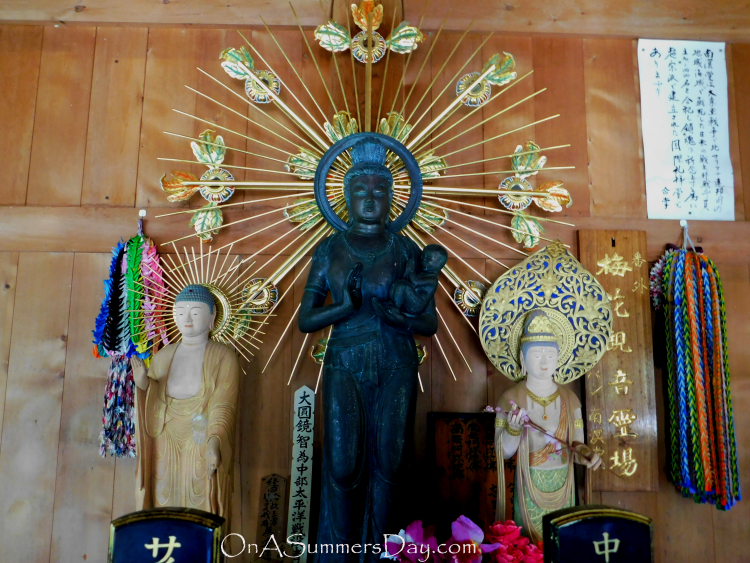
Saipan International House of Prayer
However, the most incredible part of the Prayer House is the large bell hanging in the middle of the room. The Bell of Peace/Bell of Love is said to give anyone who rings it eternal peace and love and bless them with great joy and happiness. The sound it makes is something you must experience for yourself. It is the meaning of the word divine.
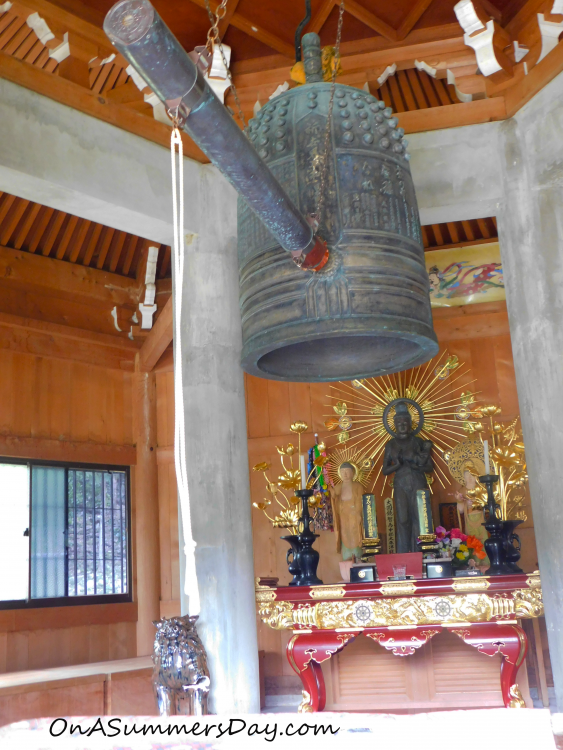
Saipan International House of Prayer
Saipan Island Oddity #7 – Abandoned Cold War Radio Tower
Head north down Middle Road, and stay on it as it becomes Route 30 to the Village of San Roque. There, just past the Kensington Hotel, you will turn right onto Route 302. Stay on this road as it twists and turns for just under a mile. You then come to Middle Road, where you will turn right. Follow this about a mile and a quarter until the left, unpaved turnoff appears. Follow this road past the newly installed cell towers, and you will find one of Saipan’s oddest oddities.
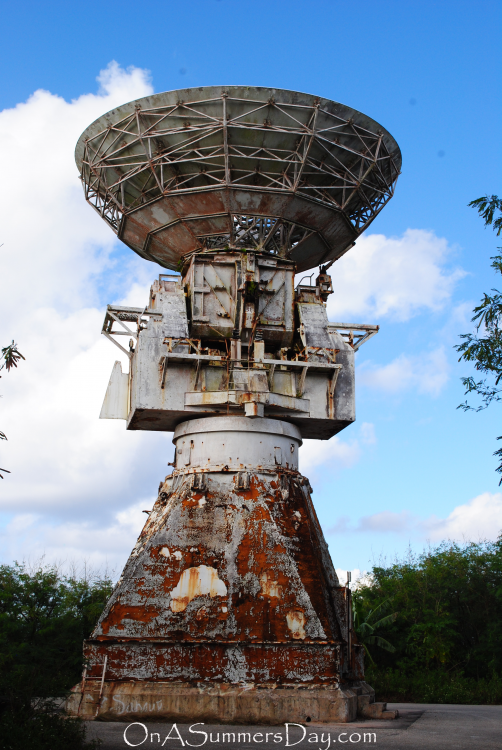
Cold War Radio Tower | Saipan
The Cold War radio tower was commissioned in the 1980’s to fill in a gap of coverage between the Philippines and The Marshall Islands. The radio tower was completed in 1989, which was about as bad timing as possible. The Cold War ended soon after, and the tower was abandoned.
These days, it is covered with rust and graffiti. Almost all the buildings that were built along with it have been taken back by the jungle. But the view is extraordinary and well worth the drive up the mountain.
Saipan Island Oddity #8 – Suicide Cliff Postcard
Come back down the mountain, and turn north back onto Route 30. Directly across the street from the Mariana Resort is the next Island Oddity.
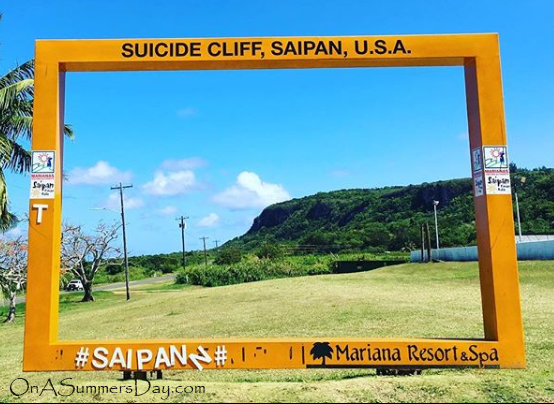
Suicide Cliff Postcard | Saipan
Pull over and park in the field across from the Mariana Resort & Spa. From here you can snag you a quick “postcard” picture. Framed out perfectly is Saipan’s most notorious landmark, Suicide Cliff. Perspective pictures can be super fun through this frame, as well.
Saipan Island Oddity #8 – SAIPAN Sign
Keep heading north towards the Suicide Cliff. Take the turn to Bird Island, and as you come around the bend you will find our next oddity.
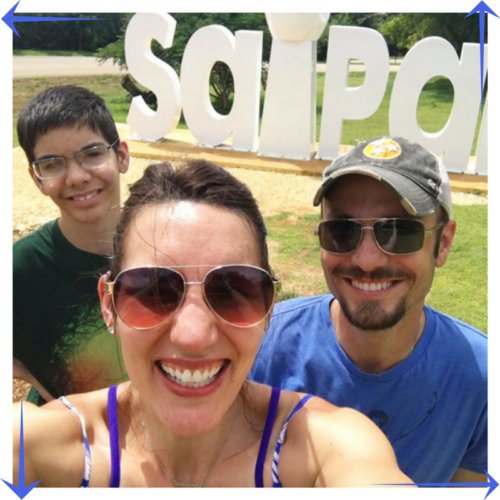
Hafa Adai! | Saipan
The SAIPAN sign is not one to miss while you’re out sightseeing. This is a particular favorite spot of tourists who drive pastel colored sports cars.
Saipan Island Oddity #9 – Kalabera Cave
Continue on the road past Bird Island, where it becomes a dirt road. Follow this bumpy road a mile or so until you see the parking lot for this next oddity.
To the right, you will come upon a re-creation of an ancient Chamorro housing called latte stone houses. These houses were built as far back as 3,000 years ago. The latte stone is unique to the Mariana Islands, and are similar to the Easter Island moai in size.
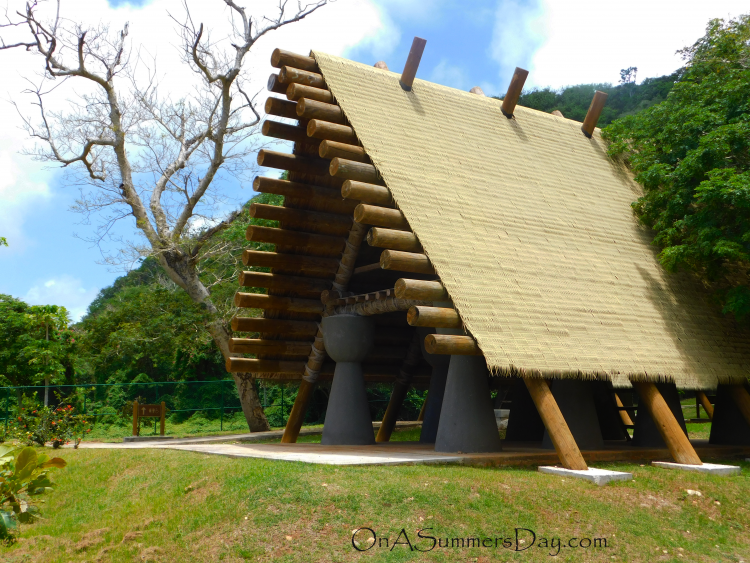
Latte Stone home | Saipan
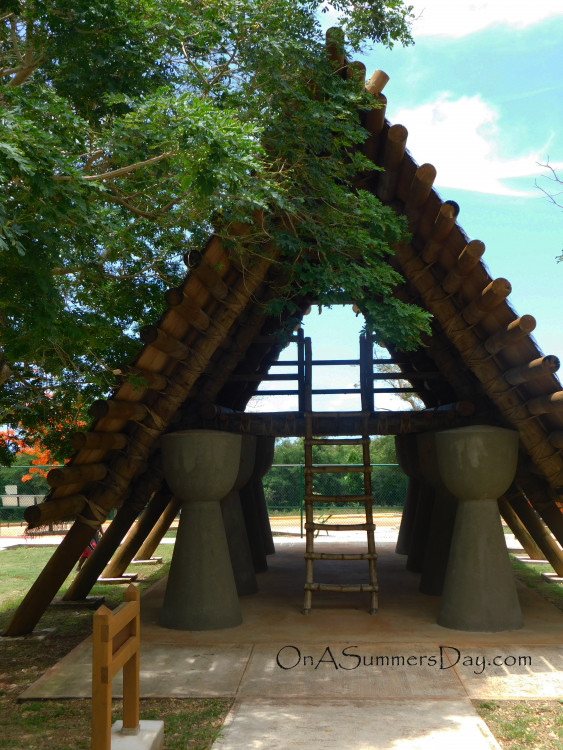
Latte stone home | Saipan
Behind these houses, you will find a very nice walkway that circles the entire park. This walkway was once the old sugar cane railroad tracks.
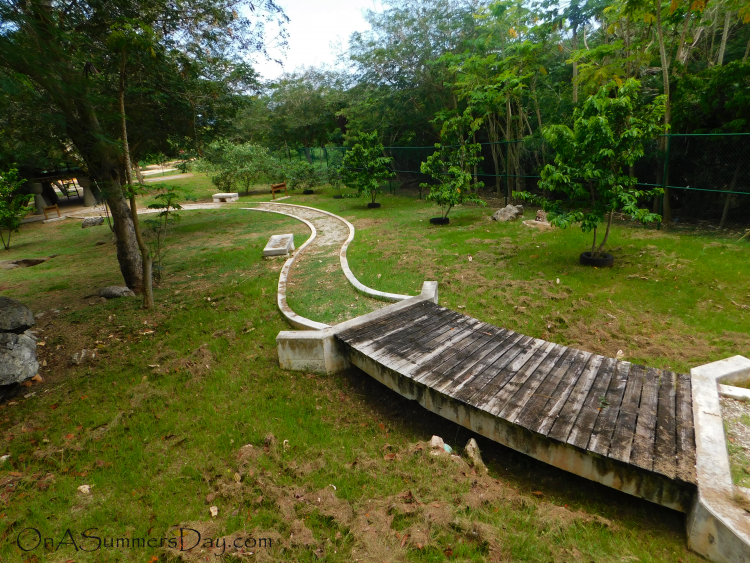
Choo Choo! | Saipan
Follow that to a wooden walkway that leads to the ninth Island Oddity – the Kalabera Cave. This spooky cave is surrounded by legends.
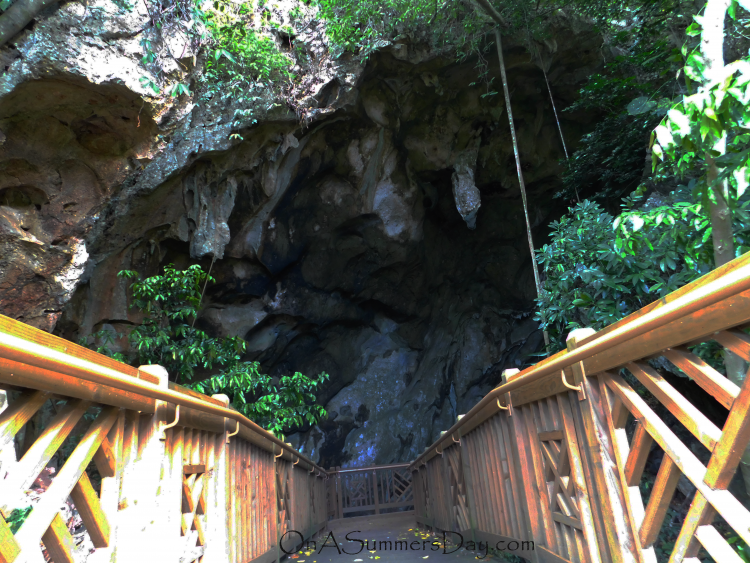
Kalabera Cave | Saipan
It is no longer open to the public beyond a deep opening and wide platform at the entrance of the cave, but looking down into the seemingly endless darkness it’s easy to understand why. Legends say the Spanish used it as a prison. It is known that the Japanese used it during the World War 2 as a hospital, and possibly to hide in once the Americans took the island.
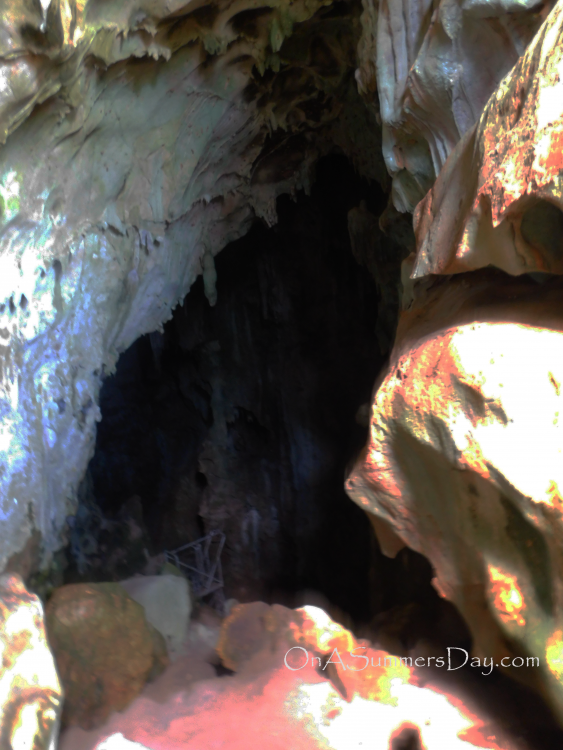
Kalabera Cave | Saipan
Ancient Chamorro petroglyphs can be seen on the walls near the left-side entrance. But, do be warned. I have never had one picture, taken by myself or anyone I know, taken from inside this cave that didn’t come out blurry. The energy in this cave is super eerie. If you don’t believe in spirits, you just might after this cave!
Saipan Island Oddity #10 – Mermaid In The Jungle
I saved the best, and my very favorite, for last. Take a right onto the road out of Kalabera Cave. Drive a mile or so down the road. (You will most likely need chiropractic care after this road-trip. The roads in Saipan are not easy on your spinal alignment, or your car’s either.)
Just before you come to the end of the road, on the right side you will see what looks like an old, red picnic canopy that is very rusted, and the jungle is trying to overtake. There is an empty yard to the right of it, and what appears to be a wooden stake were there might have been a road sign once before, a very long time ago in front of it. Park in the empty lot beside it. Come inside the canopy area – watch out for dirt dobbers. Look for a small set of stairs leading into the jungle on the far back, left side of the canopy.
Now, don’t be afraid. Because you are going into the jungle.
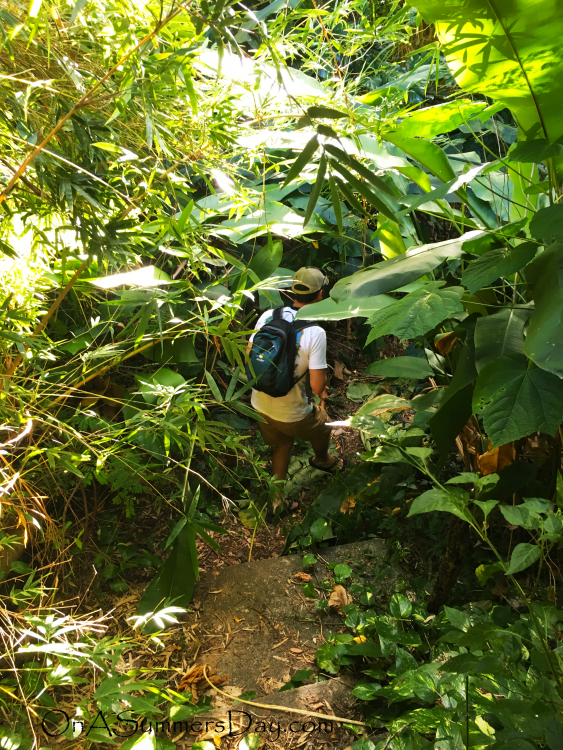
Watch your step! | Saipan
Saipan has no snakes. But do watch out for spider webs.
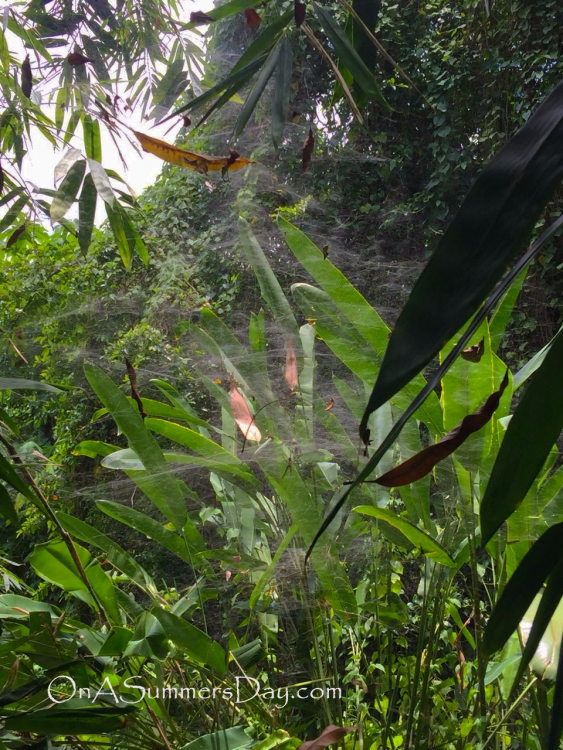
Photo creds to Brandy Davis
For those of you who haven’t given up after I said “spider webs” – there is a real surprise waiting for you. For at the bottom of that very overgrown staircase is an incredible cave. And standing guard in front of this cave is the Mermaid of the Jungle.
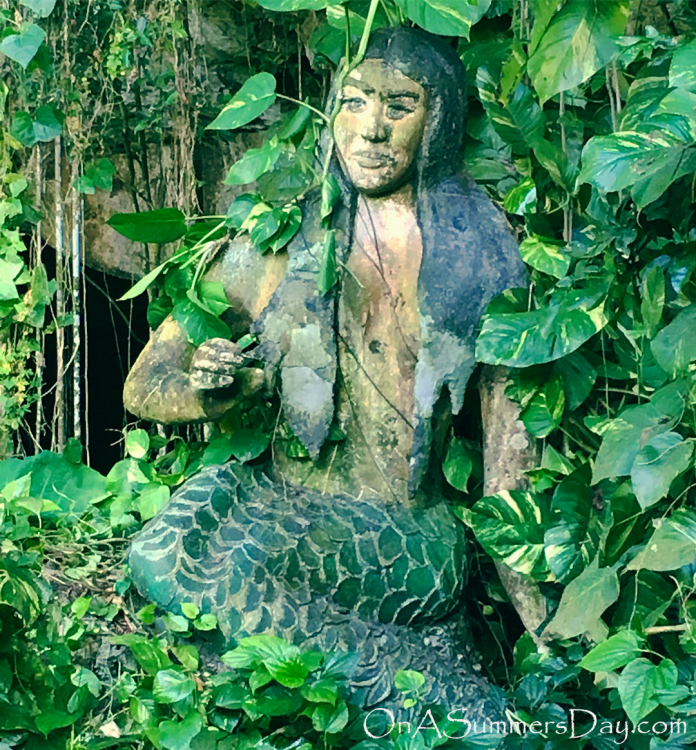
Mermaid of the Jungle | Saipan
No one knows how old she is, or how she got here. All we really know is that she is really large. She’s easily over ten feet tall, and there’s no telling how heavy she is.
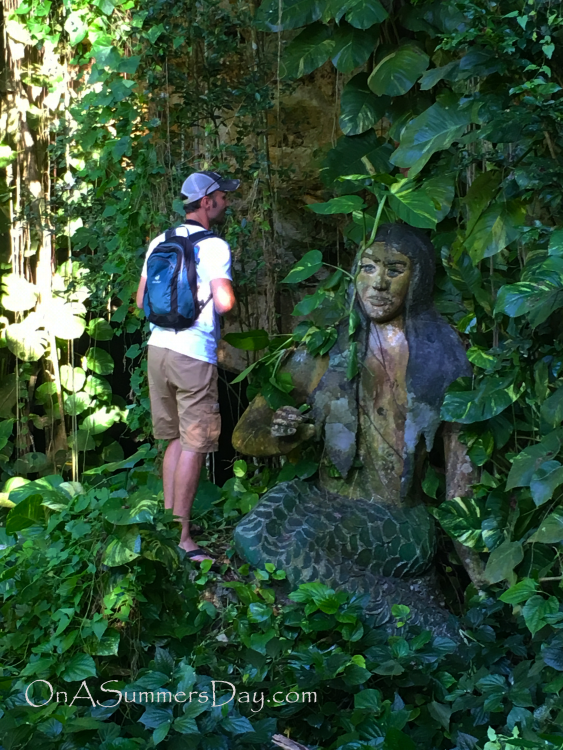
Mermaid In The Jungle | Saipan
The caves behind her are no longer safe to explore due to high methane gasses being detected inside them. And depending on how long it’s been since her last haircut, the mermaid can get really overgrown by the jungle. So be careful when you go to see her. Maybe wear pants and closed toe shoes, too?

Mermaid In The Jungle | Saipan
I hope you enjoyed getting a peek into some of Saipan’s more unique attractions. I love this little rock that I call home. All her quirks are what makes her so charming to me.
What was your favorite oddity? Would you rather snorkel around the tanks or hike through the jungle in hunt of a mermaid? Can you even believe there is a mermaid in the jungle? I know – crazy, right? Let’s dish about it in the comments!
Thanks for stopping by. Want to pin this blog post? Maybe this will work?


[…] are almost no places I would be willing to give up my beloved Saipan and relocate to, with a few […]